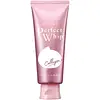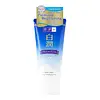What's inside
What's inside
 Key Ingredients
Key Ingredients

 Benefits
Benefits

 Concerns
Concerns

 Ingredients Side-by-side
Ingredients Side-by-side

Water
Skin ConditioningStearic Acid
CleansingMyristic Acid
CleansingPEG-8
HumectantPotassium Hydroxide
BufferingLauric Acid
CleansingGlycerin
HumectantDipropylene Glycol
HumectantBeeswax
Emulsion StabilisingPolyquaternium-7
PEG-90m
Emulsion StabilisingPEG/PPG-14/7 Dimethyl Ether
Skin ConditioningSodium Hyaluronate
HumectantSodium Acetylated Hyaluronate
HumectantHydrolyzed Silk
HumectantSoluble Collagen
HumectantAlcohol Denat.
AntimicrobialPolyquaternium-112
Disodium EDTA
Sodium Metabisulfite
AntioxidantSilica
AbrasiveBHT
AntioxidantCitric Acid
BufferingSorbic Acid
PreservativeSodium Benzoate
MaskingPhenoxyethanol
PreservativeParfum
MaskingCI 77492
Cosmetic ColorantWater, Stearic Acid, Myristic Acid, PEG-8, Potassium Hydroxide, Lauric Acid, Glycerin, Dipropylene Glycol, Beeswax, Polyquaternium-7, PEG-90m, PEG/PPG-14/7 Dimethyl Ether, Sodium Hyaluronate, Sodium Acetylated Hyaluronate, Hydrolyzed Silk, Soluble Collagen, Alcohol Denat., Polyquaternium-112, Disodium EDTA, Sodium Metabisulfite, Silica, BHT, Citric Acid, Sorbic Acid, Sodium Benzoate, Phenoxyethanol, Parfum, CI 77492
Water
Skin ConditioningButylene Glycol
HumectantSodium Myristoyl Glutamate
CleansingSorbitol
HumectantSodium Lauroyl Glutamate
Sodium Methyl Cocoyl Taurate
CleansingCocamide DEA
EmulsifyingMyristic Acid
CleansingSodium Chloride
MaskingLauric Acid
CleansingPEG-40
HumectantHydrogenated Castor Oil
EmollientGlyceryl Stearate
EmollientPEG-100 Stearate
Hydroxyacetophenone
AntioxidantPolyglycerin-6
HumectantCitrus Paradisi Peel Oil
MaskingCitrus Aurantium Dulcis Peel Oil
MaskingMoringa Oil/Hydrogenated Moringa Oil Esters
Skin ConditioningGlycerin
HumectantArbutin
AntioxidantPhytic Acid
Sodium Hyaluronate
HumectantCeramide AP
Skin Conditioning1,2-Hexanediol
Skin ConditioningAngelica Polymorpha Sinensis Root Extract
Skin ConditioningBiosaccharide Gum-4
Skin ConditioningSodium Acetylated Hyaluronate
HumectantBletilla Striata Root Extract
Skin ConditioningMorus Alba Bark Extract
Skin ConditioningPaeonia Albiflora Root Extract
Skin ConditioningAmpelopsis Japonica Root Extract
Skin ConditioningAtractylodes Macrocephala Root Extract
Skin ConditioningPerilla Frutescens Leaf Extract
MaskingPoria Cocos Extract
Skin ConditioningSyringa Oblata Bark/Leaf Powder
AbrasivePhenoxyethanol
PreservativeMoringa Oleifera Seed Extract
Skin ConditioningDisodium Phosphate
BufferingCitric Acid
BufferingHydroxypropyltrimonium Hyaluronate
Methylparaben
PreservativeWater, Butylene Glycol, Sodium Myristoyl Glutamate, Sorbitol, Sodium Lauroyl Glutamate, Sodium Methyl Cocoyl Taurate, Cocamide DEA, Myristic Acid, Sodium Chloride, Lauric Acid, PEG-40, Hydrogenated Castor Oil, Glyceryl Stearate, PEG-100 Stearate, Hydroxyacetophenone, Polyglycerin-6, Citrus Paradisi Peel Oil, Citrus Aurantium Dulcis Peel Oil, Moringa Oil/Hydrogenated Moringa Oil Esters, Glycerin, Arbutin, Phytic Acid, Sodium Hyaluronate, Ceramide AP, 1,2-Hexanediol, Angelica Polymorpha Sinensis Root Extract, Biosaccharide Gum-4, Sodium Acetylated Hyaluronate, Bletilla Striata Root Extract, Morus Alba Bark Extract, Paeonia Albiflora Root Extract, Ampelopsis Japonica Root Extract, Atractylodes Macrocephala Root Extract, Perilla Frutescens Leaf Extract, Poria Cocos Extract, Syringa Oblata Bark/Leaf Powder, Phenoxyethanol, Moringa Oleifera Seed Extract, Disodium Phosphate, Citric Acid, Hydroxypropyltrimonium Hyaluronate, Methylparaben
 Reviews
Reviews

Ingredients Explained
These ingredients are found in both products.
Ingredients higher up in an ingredient list are typically present in a larger amount.
Citric Acid is an alpha hydroxy acid (AHA) naturally found in citrus fruits like oranges, lemons, and limes.
Like other AHAs, citric acid can exfoliate skin by breaking down the bonds that hold dead skin cells together. This helps reveal smoother and brighter skin underneath.
However, this exfoliating effect only happens at high concentrations (20%) which can be hard to find in cosmetic products.
Due to this, citric acid is usually included in small amounts as a pH adjuster. This helps keep products slightly more acidic and compatible with skin's natural pH.
In skincare formulas, citric acid can:
While it can provide some skin benefits, research shows lactic acid and glycolic acid are generally more effective and less irritating exfoliants.
Most citric acid used in skincare today is made by fermenting sugars (usually from molasses). This synthetic version is identical to the natural citrus form but easier to stabilize and use in formulations.
Read more about some other popular AHA's here:
Learn more about Citric AcidGlycerin is already naturally found in your skin. It helps moisturize and protect your skin.
A study from 2016 found glycerin to be more effective as a humectant than AHAs and hyaluronic acid.
As a humectant, it helps the skin stay hydrated by pulling moisture to your skin. The low molecular weight of glycerin allows it to pull moisture into the deeper layers of your skin.
Hydrated skin improves your skin barrier; Your skin barrier helps protect against irritants and bacteria.
Glycerin has also been found to have antimicrobial and antiviral properties. Due to these properties, glycerin is often used in wound and burn treatments.
In cosmetics, glycerin is usually derived from plants such as soybean or palm. However, it can also be sourced from animals, such as tallow or animal fat.
This ingredient is organic, colorless, odorless, and non-toxic.
Glycerin is the name for this ingredient in American English. British English uses Glycerol/Glycerine.
Learn more about GlycerinLauric Acid is a fatty acid or lipid. About half of fatty acids in coconut oil is lauric acid.
This ingredient helps hydrate and sooth skin. As a humectant, it helps trap moisture. It also aids in cleaning and enhancing the texture of products.
Lauric acid may not be Malassezia folliculitis, or fungal acne, safe.
Learn more about Lauric AcidMyristic Acid is a saturated fatty acid. It is naturally found in milk fat. Other sources include palm oil, coconut oil, and butter fat.
Myristic Acid is an emulsifer and cleanser. As an emulsifer, it stabilizes a product by preventing ingredients from separating. Myristic Acid helps clean your skin by acting as a surfactant. It tends to gather oil and dirt on your skin to be easily rinsed away.
One study from 2021 found Myristic Acid to have anti-inflammatory properties.
Learn more about Myristic AcidPhenoxyethanol is a preservative that has germicide, antimicrobial, and aromatic properties. Studies show that phenoxyethanol can prevent microbial growth. By itself, it has a scent that is similar to that of a rose.
It's often used in formulations along with Caprylyl Glycol to preserve the shelf life of products.
Sodium Acetylated Hyaluronate is a type of Hyaluronic Acid.
Hyaluronic Acids help moisturize, soothe, and protect the skin.
Read about common types of Hyaluronic Acid here:
Sodium Hyaluronate
Hydrolyzed Hyaluronic Acid
Hyaluronic Acid
Sodium Hyaluronate is hyaluronic acid's salt form. It is commonly derived from the sodium salt of hyaluronic acid.
Like hyaluronic acid, it is great at holding water and acts as a humectant. This makes it a great skin hydrating ingredient.
Sodium Hyaluronate is naturally occurring in our bodies and is mostly found in eye fluid and joints.
These are some other common types of Hyaluronic Acid:
Learn more about Sodium HyaluronateWater. It's the most common cosmetic ingredient of all. You'll usually see it at the top of ingredient lists, meaning that it makes up the largest part of the product.
So why is it so popular? Water most often acts as a solvent - this means that it helps dissolve other ingredients into the formulation.
You'll also recognize water as that liquid we all need to stay alive. If you see this, drink a glass of water. Stay hydrated!
Learn more about Water